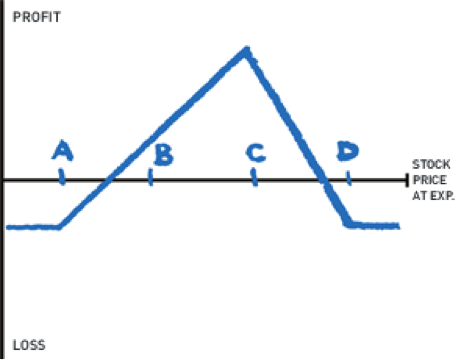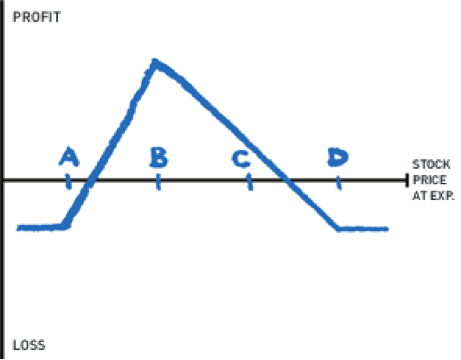 Today I would like to discuss another variation of The Butterfly options strategy that is similar to the Broken Wing Butterfly, but not exactly so. It may seem complicated at first, but it really isn’t. And, because you are neither net long nor short options, the risk is easily definable. This variation is called The Christmas Tree options strategy.
Today I would like to discuss another variation of The Butterfly options strategy that is similar to the Broken Wing Butterfly, but not exactly so. It may seem complicated at first, but it really isn’t. And, because you are neither net long nor short options, the risk is easily definable. This variation is called The Christmas Tree options strategy.
Let’s look at a call Christmas Tree. You are long one call strike A. You skip strike B. You sell three calls strike C and buy two calls, strike D. All strikes must be equidistant from each other. Normally the stock will be right around strike A. It is a moderately bullish strategy as you want the stock to move to strike C and stop.
The P&L graph looks like this:
You can see that you are buying one long call spread, strikes A/C while selling two call spreads strikes C/D. Because the long spread will skip strike B, the distance between those strikes is twice as wide as the strikes in the short call spread. So, if the width from A to C is 10, the width from C to D must be 5.
Ideally, you want strikes C and D to expire worthless with strike A at its maximum value. That makes your maximum profit strike C minus strike A minus the net debit paid. Your maximum risk is limited to the net debit paid. The strategy has two breakeven points: Strike A plus the debit paid and strike D minus half of the debit paid.
The lower you buy strike A, the more bullish the strategy. With this strategy you will want implied volatility to decrease, which is normally the case when a stock moves higher.
Let’s look at a put Christmas Tree options strategy:
You buy one put strike D. Skip strike C and sell three puts, strike B. You then buy two puts, strike A. Remember, all strikes must be equidistant from each other.
Your view is slightly bearish with the stock at or around strike D. The higher strike D the more bearish you are. You want the stock to move lower to strike B and then stop. Your maximum risk is the debit paid. Your maximum profit is strike D minus strike B minus the debit paid. And, again, you have two break even points. Strike D minus the debit and strike A plus the net debit paid.
This is not a strategy to put on if you expect a violent move lower. Ideally, you want everything but strike D to go out worthless as the stock slowly drifts to strike B.
The Christmas Tree, call or put, is a defined and limited risk, good reward all options strategy. Just the sort of play that I like. For more strategies and options information, you can catch me on The Liss Report.
Twitter: @RandallLiss
No positions in any of the mentioned securities at the time of publication. Any opinions expressed herein are solely those of the author, and do not in any way represent the views or opinions of any other person or entity.










